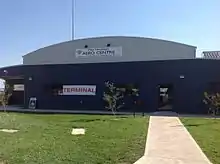Orange Airport
Orange Regional Airport (IATA: OAG, ICAO: YORG) is located in the Central Tablelands region of New South Wales between the city of Orange[1] and the town of Blayney. It is located in the area known as Huntley, near Spring Hill and approximately 11 km (6.8 mi) from Orange's business district.
Orange Regional Airport | |||||||||||||||
|---|---|---|---|---|---|---|---|---|---|---|---|---|---|---|---|
 | |||||||||||||||
| Summary | |||||||||||||||
| Airport type | Public | ||||||||||||||
| Operator | Orange City Council | ||||||||||||||
| Serves | Orange, New South Wales, Australia | ||||||||||||||
| Location | Huntley / Spring Hill | ||||||||||||||
| Elevation AMSL | 3,115 ft / 949 m | ||||||||||||||
| Coordinates | 33°22′54″S 149°07′59″E | ||||||||||||||
| Website | http://www.orange.nsw.gov.au/site/index.cfm?display=147100 | ||||||||||||||
| Map | |||||||||||||||
 YORG Location in New South Wales | |||||||||||||||
| Runways | |||||||||||||||
| |||||||||||||||
Facilities
At an elevation of 3,115 ft (949 m) above sea level, the airport is Australia's third-highest airport, behind Mount Hotham Airport and Armidale Airport. It has two runways: 11/29 with an asphalt surface measuring 2,213 m × 30 m (7,260 ft × 98 ft) and 04/22 with a grassed red clay surface measuring 783 m × 30 m (2,569 ft × 98 ft).[1] In April 1976, it became the first airport in Australia to have a pilot-controlled lighting system installed.[2]
Terminal upgrade and airport extension
As part of a larger upgrade to the airport, the old terminal building was closed on 21 September 2013 and demolished in the following weeks. Construction of the new terminal was estimated to cost A$3.3 million.[3][4] A two-year project to extend the airport's main runway by 538 metres (1,765 feet) commenced around the same time, and was completed in 2015.[5]
In August 2014, the airport's new terminal opened, which featured dedicated departures and arrivals areas; room for facilities for three airlines; a cafe and a conveyor belt system. The terminal has no security screening, meaning that despite the improvements to the airport's runways, aircraft with over 50 seats remain unable to offer services from the airport.
Airlines and destinations
| Airlines | Destinations |
|---|---|
| Link Airways | Brisbane,[6] Melbourne–Essendon[7] |
| QantasLink | Sydney[8][9] |
| Regional Express Airlines | Sydney |
Other airport users
Orange Aero Club
Originally established in the 1930s, the Orange Aero Club is a social and flying club based at the airport. The club hosts regular flying competitions and fly-aways from its new building, the Max Hazelton Aero Centre, named after the founder of Hazelton Airlines.[10]
Flight training
There are a small number of flying schools based at the airport accommodating training in both fixed-wing and rotary-wing aircraft.
Statistics
Orange Airport was ranked 53rd in Australia for the number of revenue passengers served in financial year 2010-2011.[11][12]
| Year[11] | Revenue passengers | Aircraft movements |
|---|---|---|
| 2001-02 | 38,820 | 3,086 |
| 2002-03 | 37,856 | 2,597 |
| 2003-04 | 48,945 | 2,381 |
| 2004-05 | 57,294 | 2,512 |
| 2005-06 | 56,576 | 2,528 |
| 2006-07 | 58,252 | 2,519 |
| 2007-08 | 60,736 | 2,568 |
| 2008-09 | 54,560 | 2,468 |
| 2009-10 | 53,379 | 2,308 |
| 2010-11 | 59,840 | 2,315 |
See also
References
- YORG – Orange (PDF). AIP En Route Supplement from Airservices Australia, effective 05 Nov 2020, Aeronautical Chart Archived 11 April 2012 at the Wayback Machine
- Airlines Australian Transport May 1976 page 13
- Airport upgrade gets final approval orange.nsw.gov.au, published: 1 October 2013, accessed: 19 November 2013
- Air travellers start using new terminal orange.nsw.gov.au, published: 23 September 2013, accessed: 19 November 2013
- "Airport Expansion". Orange City Council website. Retrieved 2 January 2017.
- "Announcement Of Direct Flights Between Orange And Brisbane". Retrieved 16 December 2016.
- "Announcement Of Direct Flights Between Orange & Melbourne". Fly Corporate. Retrieved 4 August 2017.
- Qantas spreads its wings to Orange Australian Aviation
- "Qantas group network changes". Qantas. 19 March 2020. Retrieved 20 March 2020.
- "Club History". Orange Aero Club. Retrieved 2 January 2017.
- Fiscal year 1 July - 30 June
- "Airport Traffic Data 1985-86 to 2010-11". Bureau of Infrastructure, Transport and Regional Economics (BITRE). May 2012. Archived from the original on 24 March 2012. Retrieved 8 May 2012. Refers to "Regular Public Transport (RPT) operations only"
External links
| Wikimedia Commons has media related to Orange Airport. |